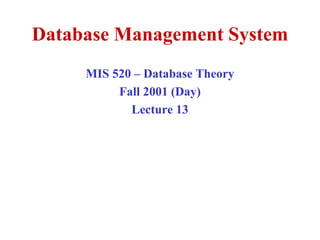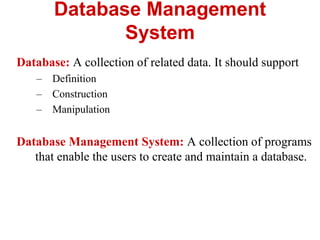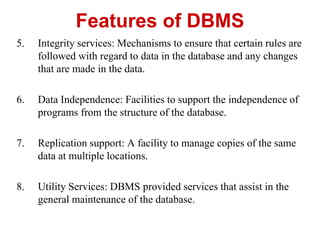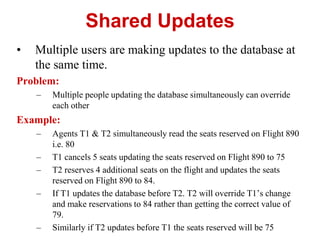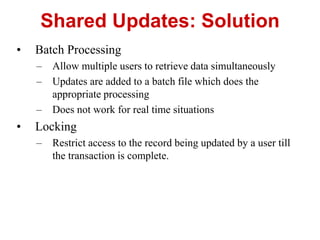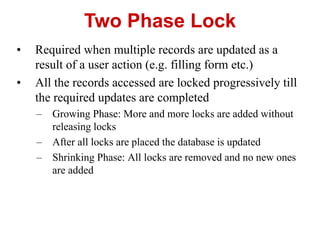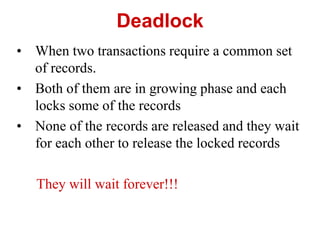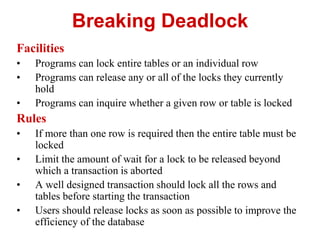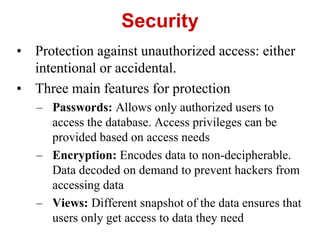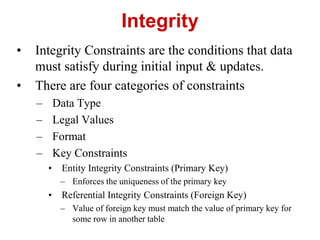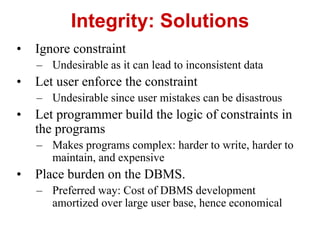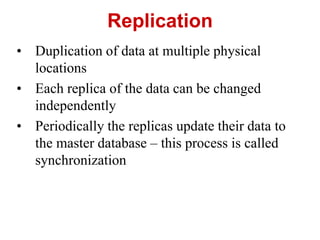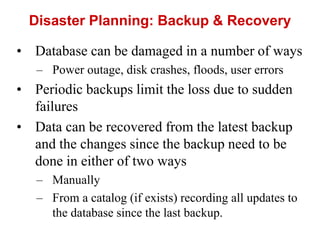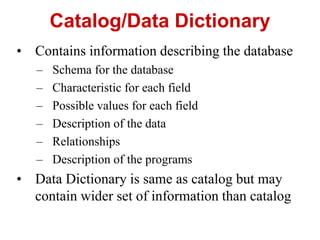dbms.ppt
- 1. Database Management System MIS 520 â Database Theory Fall 2001 (Day) Lecture 13
- 2. Database Management System Database: A collection of related data. It should support â Definition â Construction â Manipulation Database Management System: A collection of programs that enable the users to create and maintain a database.
- 3. Features of DBMS 1. Data storage, retrieval, and update: The ability to store, retrieve, and update the data that are in the database. 2. User-accessible catalog: where descriptions of database components are stored and are accessible to the users 3. Shared update support: A mechanism to ensure accuracy when several users are updating the database at the same time 4. Backup and Recovery Services: Mechanisms for recovering the database in the event that a database is damaged somehow. 5. Security Services: Mechanisms to ensure that certain rules are followed with regard to data in the database and any changes that are made in the data
- 4. Features of DBMS 5. Integrity services: Mechanisms to ensure that certain rules are followed with regard to data in the database and any changes that are made in the data. 6. Data Independence: Facilities to support the independence of programs from the structure of the database. 7. Replication support: A facility to manage copies of the same data at multiple locations. 8. Utility Services: DBMS provided services that assist in the general maintenance of the database.
- 5. Shared Updates âĒ Multiple users are making updates to the database at the same time. Problem: â Multiple people updating the database simultaneously can override each other Example: â Agents T1 & T2 simultaneously read the seats reserved on Flight 890 i.e. 80 â T1 cancels 5 seats updating the seats reserved on Flight 890 to 75 â T2 reserves 4 additional seats on the flight and updates the seats reserved on Flight 890 to 84. â If T1 updates the database before T2. T2 will override T1âs change and make reservations to 84 rather than getting the correct value of 79. â Similarly if T2 updates before T1 the seats reserved will be 75
- 6. Shared Updates: Solution âĒ Batch Processing â Allow multiple users to retrieve data simultaneously â Updates are added to a batch file which does the appropriate processing â Does not work for real time situations âĒ Locking â Restrict access to the record being updated by a user till the transaction is complete.
- 7. Two Phase Lock âĒ Required when multiple records are updated as a result of a user action (e.g. filling form etc.) âĒ All the records accessed are locked progressively till the required updates are completed â Growing Phase: More and more locks are added without releasing locks â After all locks are placed the database is updated â Shrinking Phase: All locks are removed and no new ones are added
- 8. Deadlock âĒ When two transactions require a common set of records. âĒ Both of them are in growing phase and each locks some of the records âĒ None of the records are released and they wait for each other to release the locked records They will wait forever!!!
- 9. Breaking Deadlock Facilities âĒ Programs can lock entire tables or an individual row âĒ Programs can release any or all of the locks they currently hold âĒ Programs can inquire whether a given row or table is locked Rules âĒ If more than one row is required then the entire table must be locked âĒ Limit the amount of wait for a lock to be released beyond which a transaction is aborted âĒ A well designed transaction should lock all the rows and tables before starting the transaction âĒ Users should release locks as soon as possible to improve the efficiency of the database
- 10. Security âĒ Protection against unauthorized access: either intentional or accidental. âĒ Three main features for protection â Passwords: Allows only authorized users to access the database. Access privileges can be provided based on access needs â Encryption: Encodes data to non-decipherable. Data decoded on demand to prevent hackers from accessing data â Views: Different snapshot of the data ensures that users only get access to data they need
- 11. Integrity âĒ Integrity Constraints are the conditions that data must satisfy during initial input & updates. âĒ There are four categories of constraints â Data Type â Legal Values â Format â Key Constraints âĒ Entity Integrity Constraints (Primary Key) â Enforces the uniqueness of the primary key âĒ Referential Integrity Constraints (Foreign Key) â Value of foreign key must match the value of primary key for some row in another table
- 12. Integrity: Solutions âĒ Ignore constraint â Undesirable as it can lead to inconsistent data âĒ Let user enforce the constraint â Undesirable since user mistakes can be disastrous âĒ Let programmer build the logic of constraints in the programs â Makes programs complex: harder to write, harder to maintain, and expensive âĒ Place burden on the DBMS. â Preferred way: Cost of DBMS development amortized over large user base, hence economical
- 13. Replication âĒ Duplication of data at multiple physical locations âĒ Each replica of the data can be changed independently âĒ Periodically the replicas update their data to the master database â this process is called synchronization
- 14. Disaster Planning: Backup & Recovery âĒ Database can be damaged in a number of ways â Power outage, disk crashes, floods, user errors âĒ Periodic backups limit the loss due to sudden failures âĒ Data can be recovered from the latest backup and the changes since the backup need to be done in either of two ways â Manually â From a catalog (if exists) recording all updates to the database since the last backup.
- 15. Catalog/Data Dictionary âĒ Contains information describing the database â Schema for the database â Characteristic for each field â Possible values for each field â Description of the data â Relationships â Description of the programs âĒ Data Dictionary is same as catalog but may contain wider set of information than catalog

